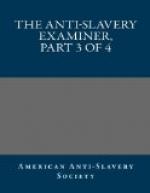“Col. Robert H. Watkins had a runaway slave, who was called Jim Dragon. Before he was caught the last time, he had been out a year, within a few miles of his master’s plantation. He never stole from any one but his master, except when necessity compelled him. He said he had a right to take from his master; and when taken, that he had, whilst out, seen his master a hundred times. Having been whipped, clogged with irons, and yoked, he was set at work in the field. Col. Watkins worked about 300 hands—generally had one negro out hunting runaways. After employing a physician for some time among his negroes, he ceased to do so, alleging as the reason, that it was cheaper to lose a few negroes every year than to pay a physician. He was a Presidential elector in 1836.
“Col. Ben Sherrod, another large planter in that neighborhood, is remarkable for his kindness to his slaves. He said to Rev. Mr. Barr, that he had no doubt he should be rewarded in heaven for his kindness to his slaves; and yet his overseer, Walker, had to sleep with loaded pistols, for fear of assassination. Three of the slaves attempted to kill him once, because of his treatment of their wives.
“Old Major Billy Watkins was noted for his severity. I well remember, when he lived in Madison county, to have often heard him yell at his negroes with the most savage fury. He would stand at his house, and watch the slaves picking cotton; and if any of them straitened their backs for a moment, his savage yell would ring, ‘bend your backs.’
“Mrs. Barr stated, that Mrs. H——, of Courtland, a member of the Presbyterian church, sent a little negro girl to jail, suspecting that she had attempted to put poison in the water pail. The fact was, that the child had found a vial, and was playing in the water. This same woman (in high standing too,) told the Rev. Mr. McMillan, that she could ‘cut Arthur Tappan’s throat from ear to ear.’
“The clothing of slaves is in many cases comfortable, and in many it is far from being so. I have very often seen slaves, whose tattered rags were neither comfortable nor decent.
“Their huts are sometimes comfortable, but generally they are miserable hovels, where male and female are herded promiscuously together.
“As to the usual allowance of food on the plantations in North Alabama, I cannot speak confidently, from personal knowledge. There was a slave named Hadley, who was in the habit of visiting my father’s slaves occasionally. He had run away several times. His reason was, as he stated, that they would not give him any meat—said he could not work without meat. The last time I saw him, he had quite a heavy iron yoke on his neck, the two prongs twelve or fifteen inches long, extending out over his shoulders and bending upwards.




